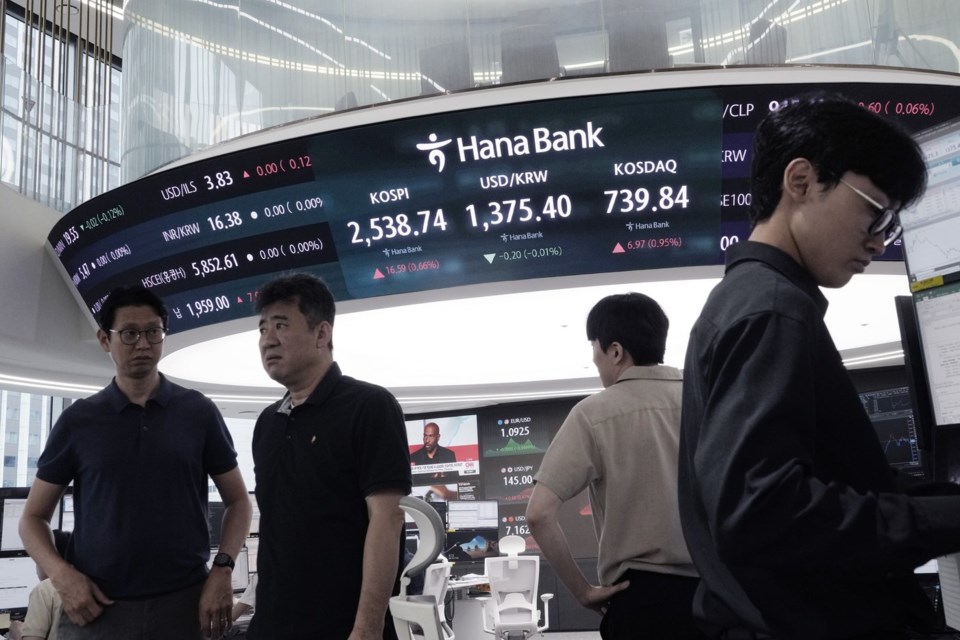Shares were mostly higher Wednesday in Asia, with Japan’s benchmark Nikkei 225 index falling shortly after the open and then bouncing as it climbed higher.
The Nikkei index was up 2.3% by midmorning, at 35,464.61.
It had soared more than 10% on Tuesday, recovering much of the losses it suffered from its .
The gains followed remarks by a Bank of Japan official who noted that even though the central bank had raised a week earlier, to 0.25% from 0.1%, monetary policy remains lax.
The interest rate hike, however modest, set in motion a domino effect of selling by traders to adjust to higher costs for carry trades — and other investors — due to higher interest rates and a rise in the value of the Japanese yen against the U.S. dollar.
The dollar rebounded sharply against the yen early Wednesday, jumping to 146.47 yen from 144.44 late Tuesday. A weaker yen tends to help profits of export manufacturers that earn most of their revenue overseas, and a surge in the yen's value after the BOJ's rate hike led to big gains for the Japanese currency late last week.
In recent months the dollar had traded at a near four decade high level of 160 yen.
The unwinding of the carry trades plus worries over the outlook for the U.S. economy sent markets tumbling late last week and into Monday's session.
Elsewhere in Asia on Wednesday, Hong Kong's Hang Seng was the outlier, giving up 0.3% to 16,647.34. The Shanghai Composite index gained 0.2%, to 2,873.25.
South Korea’s Kospi jumped 2.6% to 2,587.78 and the benchmark in Taiwan jumped more than 3% — both markets were among the biggest losers in Monday's sell-offs due to heavy weighting of technology shares that have seen the biggest losses in the past few weeks.
The S&P/ASX 200 in Australia was up 0.4% at 7,712.20.
On Tuesday, the S&P 500 climbed 1% to break a brutal three-day . It had tumbled a bit more than 6% on a raft of concerns, including worries the Federal Reserve had pressed the brakes too hard for too long on the through in order to .
The S&P 500 rose 53.70 points to 5,240.03. The Dow added 294.39, or 0.8%, to 38,997.66, and the Nasdaq gained 166.77, or 1%, to 16,366.85.
Stocks of all kinds climbed in a mirror opposite of the day before, from smaller companies that need U.S. households to keep spending to huge multinationals more dependent on the global economy.
Stronger-than-expected profit reports from several big U.S. companies helped drive the market. Kenvue, the company behind Tylenol and Band-Aids, jumped 14.7% after reporting stronger profit than expected thanks in part to higher prices for its products. Uber rolled 10.9% higher after easily topping profit forecasts for the latest quarter.
Caterpillar climbed 3% after the maker of heavy machinery reported stronger earnings than expected.
While fears are rising about a slowing U.S. economy, it is still growing, and many economists see a recession in the next year or so as unlikely. The U.S. stock market is also still up a healthy amount for the year so far, and the Federal Reserve says it has ample room to cut interest rates to help the economy if the job market weakens significantly.
The S&P 500 has romped to dozens of all-time highs this year and is still up nearly 10% so far in 2024, in part due to a technology. Critics have been saying that euphoria has sent stock prices too high in many cases.
In the bond market, Treasury yields climbed to claw back some of their sharp drops since April, which were driven by rising expectations for coming cuts to interest rates by the Federal Reserve.
The yield on the 10-year Treasury rose to 3.88% from 3.78% late Monday. It had briefly dropped below 3.70% during Monday when fear in the market was spiking and investors were speculating the Federal Reserve could even have to call an emergency meeting to cut interest rates quickly.
In other dealings early Wednesday, U.S. benchmark crude oil was down 15 cents at $73.05 per barrel. Brent crude, the international standard, declined 17 cents to $76.31.
___
AP Business Writers Stan Choe and Matt Ott contributed.
The Associated Press


